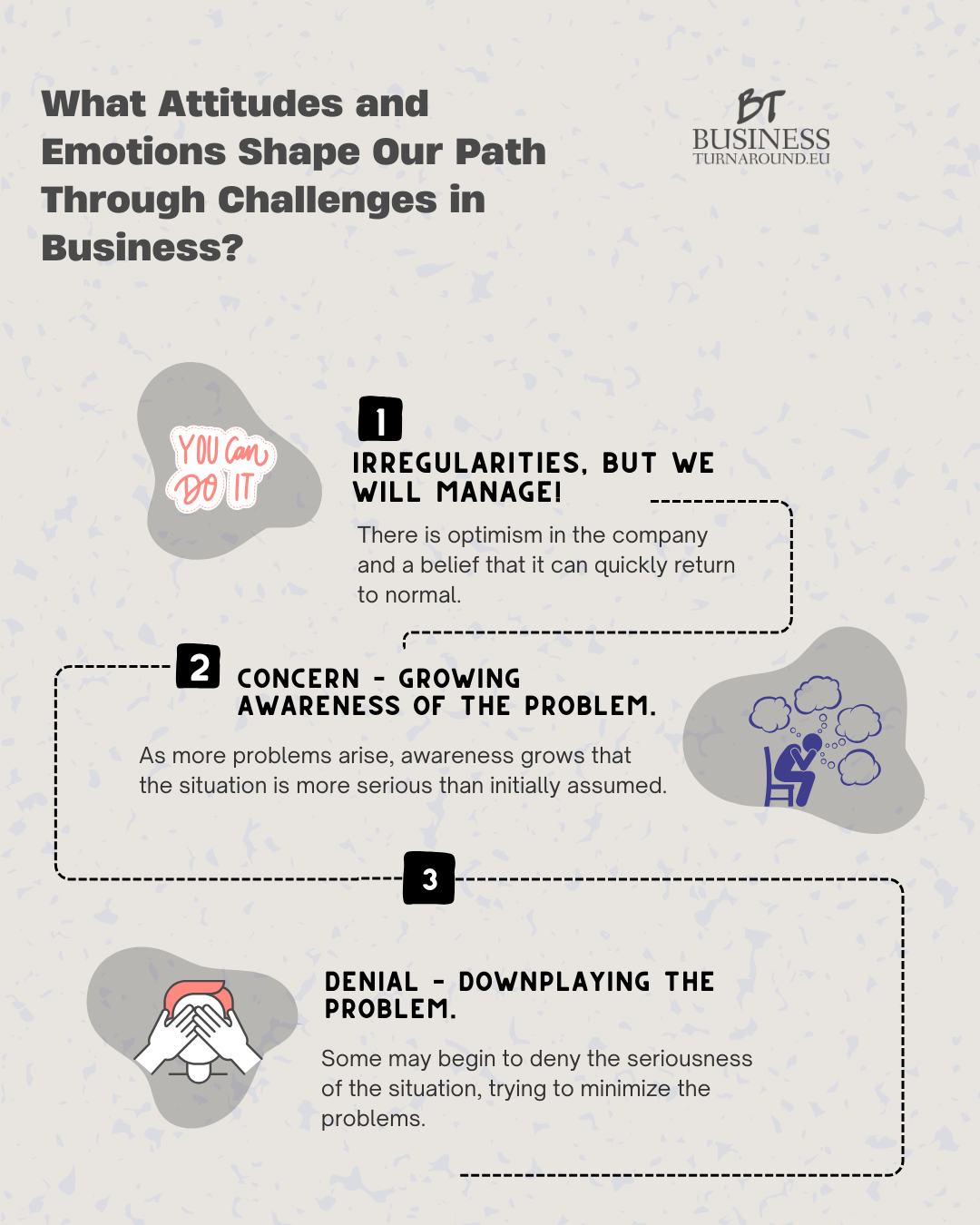What Attitudes and Emotions Shape Our Path Through Business Challenges?

At the beginning of the crisis, the first signs of problems emerge, but they are often ignored or considered easy to fix. The company is characterized by optimism and the belief that it can quickly return to normalcy.
Emotions: Hope, euphoria, slight anxiety, but no sense of threat yet.
Worry (Awareness of the Problem)
As more problems arise, awareness grows that the situation is more serious than initially assumed. Anxiety and uncertainty begin to prevail, but there is still no panic.
Emotions: Increasing stress and pressure, people begin to seek solutions, but often act chaotically.
Denial (Minimizing the Problem)
Some may start to deny the severity of the situation, trying to downplay the problems. Resistance to change and reluctance to take drastic steps may dominate at this stage.
Emotions: Frustration, irritation, attempts to maintain the status quo.
Fear and Disorientation (Realization of the Crisis Severity)
At this stage, there is a genuine understanding of the scale of the crisis. People begin to feel lost and confused as the situation spirals out of control.
Emotions: Fear, helplessness, escalating stress.
Sense of Threat (Panic)
The crisis reaches a level where it is felt as a direct threat to the survival of the company or financial stability. Panic may ensue, and the actions taken can be frantic and chaotic.
Emotions: Panic, fear, chaotic attempts to salvage the situation, internal tensions within the team.
Deep Doubt (Bottom)
This is the lowest point on the curve, where deep doubt and a sense of hopelessness dominate. At this stage, the organization or individual may feel that everything is lost and that solutions are not available.
Emotions: Depression, apathy, a sense of failure, lack of motivation.
Testing Solutions (Experiments with Responses)
As the organization or individual begins to realize that something must be done, the first attempts to rectify the situation arise. This may include testing various strategies, remedial plans, and even risky actions.
Emotions: Cautious optimism, uncertainty about the future, sometimes discouragement if attempts do not yield immediate results.
Anger and Frustration (Critical Moment)
In this phase, anger may arise: at oneself, at management, at external circumstances that led to the crisis. Frustration stems from attempts to fix things that do not produce the desired outcomes.
Emotions: Rage, blaming others, searching for culprits.
Decisive Moment (Acceptance and Change of Direction)
At this stage, the organization (or individual) faces a choice: accept the crisis and act decisively or risk further deepening the problems. This is the moment when crucial decisions about changes, restructuring plans, or ultimately shutting down operations are made.
Emotions: Awareness of the seriousness of the situation, but also a glimmer of hope that a way out of the crisis is possible.
Repair Attempts (Remedial Strategies)
At this stage, the organization implements concrete solutions, often in the form of restructuring, cost-cutting, or strategic changes. It is a time of intense work to rebuild stability.
Emotions: A mix of determination and uncertainty about whether these actions will be effective.
Restoring Balance (Success or Failure)
Depending on the effectiveness of the remedial actions, the organization may either:
- Achieve Success: The crisis is averted, and the company (or individual) returns to a path of growth and stability.
- Face Failure: If the remedial actions do not yield results, insolvency, bankruptcy, or other forms of ultimate failure may occur.
Emotions: Success: Relief, satisfaction, a sense of rebuilding. Failure: Sadness, disappointment, acceptance of failure.
© 2025 Anna Stusik-Kursa. All rights reserved.

